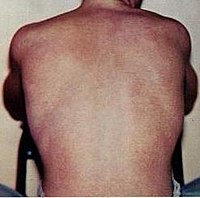
Photo from wikipedia
BackgroundNeuromyelitis optica spectrum disorder (NMOSD) is an autoimmune inflammatory disease of the central nervous system that preferentially affects the optic nerves, spinal cord, and area postrema. A series of evidence… Click to show full abstract
BackgroundNeuromyelitis optica spectrum disorder (NMOSD) is an autoimmune inflammatory disease of the central nervous system that preferentially affects the optic nerves, spinal cord, and area postrema. A series of evidence suggested that B cells play a fundamental role in the pathogenesis of NMOSD. However, there are still gaps left to be answered in NMOSD pathogenesis suggesting the roles of other immune cells. This study aimed to investigate the monocyte inflammatory characteristics, monocyte subset frequency and cytokine production, and cell-surface molecule expression in NMOSD, multiple sclerosis (MS), and healthy controls (HC).MethodsPeripheral blood mononuclear cells of 20 aquaporin 4IgG-positive NMOSD patients, 20 MS patients, and 20 healthy controls were collected to analyze the monocyte subsets and to purify monocytes. To mimic the adaptive immunity, we have activated the monocytes using CD40L and IFN-γ to observe the production of cytokines and expression of cell-surface molecules.ResultsNMOSD monocytes showed a remarkable increase in the production of pro-inflammatory cytokines (IL-6, IL-1β) and increased expression of cell-surface molecules (CD80, HLA, ICAM-1, CD16), as well as a decrease in the levels of anti-inflammatory cytokine IL-10, compared to healthy control (HC) monocytes. As expected, MS monocytes also exhibit increased inflammatory cytokine production and increased cell-surface molecule expression compared to HC monocytes. Further analysis of monocyte subsets revealed that NMOSD monocytes have an increased frequency of the non-classical monocyte subset (CD14+CD16++) and a decreased frequency of the classical monocyte subset (CD14++CD16+) compared to HC monocytes. This finding was distinctly different from that of MS monocytes, which had an increased intermediate monocyte (CD14+CD16+) subset. In addition, these NMOSD non-classical monocyte subsets were highly dedicated, IL-6-producing monocytes.ConclusionsIncreased expression of cell-surface molecules and a reciprocal dysregulation of inflammatory and anti-inflammatory cytokines in NMOSD monocytes suggest an altered monocyte inflammatory response. CD14+CD16++ non-classical monocyte subset was more abundant in NMOSD monocytes than in HC or MS monocytes, and NMOSD non-classical monocyte subset had dysregulated IL-6 production, a phenotype which has been reported to be highly associated with NMOSD pathogenesis.
Journal Title: Journal of Neuroinflammation
Year Published: 2017
Link to full text (if available)
Share on Social Media: Sign Up to like & get
recommendations!